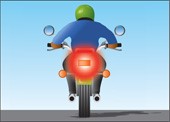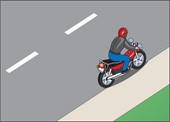Basic motorcycle and moped driving skills
This chapter tells you about the basic skills you need to drive a motorcycle or moped. Controlling your motorcycle or moped means being able to make it go exactly where you want and at the correct speed. It will take practice and experience to master the basic skills of starting, steering, turning, shifting gears and stopping. Practice off the road, in a parking lot or other spot away from traffic, until you can perform all the manoeuvres safely and confidently.
Take a motorcycle safety course
The best way to learn proper motorcycle driving techniques right from the start is to take a motorcycle safety course. You will learn good driving habits from trained instructors, increasing your chances of a safe and enjoyable driving experience. There are also safety courses available for limited-speed motorcycles. For more information on how to find a motorcycle safety course and what you will learn, visit the Ministry of Transportation website at ontario.ca/transportation.
Getting on your motorcycle or moped
Begin by making sure your vehicle is not too heavy or large for you to drive comfortably. Sitting on the seat, you should be able to place your feet flat on the ground.
If your motorcycle or moped has a kickstand, mount the vehicle from the left side and straighten it with the handlebars. With the vehicle balanced, use your left heel to kick the stand up and out of the way.
If your motorcycle or moped is resting on a centre stand, mount the vehicle and gently rock it forward until it rolls off the stand. The centre stand will spring into the “up” position. Stop the vehicle from continuing to roll forward by applying the front brake.
Always make sure to completely raise your kickstand and centre stand before driving away.
Starting your motorcycle
Depending on the age and model of your motorcycle, the starting procedure may vary. Generally, you start a motorcycle (not a limited-speed motorcycle) by turning the ignition switch on and making sure the engine kill switch is not in the “off” position. (This can happen by accident, so it is always a good idea to check.)
Shift your transmission into neutral. Set your choke as required. (How you do this will depend on whether your engine is cold, as well as the individual characteristics of your vehicle.) Pull in the clutch and press the starter button. Release the button as soon as you hear the engine fire. If your motorcycle has a kick-starter instead of an electric starter, you will need to unfold the lever, usually above the right footrest, and kick it downward to start the motorcycle.
Once the engine is going, shift into first gear and, with your feet still on the ground, slowly ease the clutch lever out until the motorcycle begins to move forward. Raise your feet and continue to ease up on the clutch, applying the throttle to give the engine enough fuel not to stall.
Starting your limited-speed motorcycle, or moped
Most modern limited-speed motorcycles have a type of automatic transmission called a continuously variable transmission, and start automatically when you turn the ignition key. Most mopeds are started by pedalling first, then turning the ignition key. You must consult your operator’s manual and learn the proper starting technique for your vehicle.
Using clutch controls and shifting gears (if applicable)
If your motorcycle is equipped with a clutch and gears, shift gears as you increase and decrease engine speed — shift up when driving faster and shift down when slowing down.
The purpose of the gears in a motorcycle transmission is to match the engine’s speed (measured by the tachometer) with the motorcycle’s speed (measured by the speedometer). The proper gear will also provide power for the motorcycle to accelerate if necessary.
Learning to co-ordinate the movements of the clutch and throttle to change gears smoothly is a critically important part of driving. Make sure you can accelerate and decelerate smoothly before you attempt to drive in traffic.
To shift up, twist the throttle as you pull in the clutch. Move the shift lever up with your toe until it stops. When you can hear and feel the gear engage, ease off on the clutch and slowly twist the throttle back up to speed.
It is more difficult to downshift smoothly than to shift up. You must twist the throttle slightly to increase engine speed as you downshift with the clutch pulled in. If you do not apply enough throttle, the motorcycle may jerk when you release the clutch. To avoid a rear-wheel skid, downshift when the engine speed is lower than the motorcycle’s speed.
Do not shift gears while you are turning. A rough, jerky downshift can cause the rear wheel to lock, resulting in a skid. Applying too much power can cause the rear tire to lose traction, also resulting in a skid. It is best to shift gears before entering a turn.
Remember: You shift up when the engine is turning too fast for the motorcycle’s speed or to increase speed, and you downshift when the engine is turning too slowly or you want to slow down.
Driving along
Steering a motorcycle or moped is very different from steering a car. When driving a motorcycle or moped, you must use your entire body to control the balance and steering of your vehicle.
Driving along, your body posture should be fairly straight. Sit close enough to the handlebars to reach them with your arms slightly bent so that you can turn the handlebars without having to stretch. Hold the handgrips firmly enough that you will not lose your grip if the motorcycle or moped bounces. Drive with your wrists low to keep you from increasing your speed by mistake. Hold your knees firmly against the gas tank for comfort and better control. To maintain your balance, keep your feet firmly on the footrests. Do not drag your foot along the ground.
Keep your toes up so they do not get caught between the road surface and the footrest. Keep your motorcycle or moped as vertical as possible, especially when accelerating.
Turning
You need to be extra careful when turning or changing lanes on a motorcycle or moped. The only way to learn how to make good, precise turns is to practice.
Slow down before entering a turn. Approach turns with extra caution until you learn to judge how fast you can actually take a turn. If you cannot hold a turn, you may end up crossing into another lane of traffic or going off the road.
If you brake too hard when turning, you may skid out of control. Check your mirrors and over your shoulder to be sure the way is clear, and signal well in advance to alert other drivers that you intend to turn or change lanes. Then lean with the vehicle into the turn. The sharper the turn and the faster your speed, the more you lean. Look well ahead in your turn. Practice keeping your head upright and facing into the turn. Remember, slow down before you begin to turn. And speed up to come out of the turn. To keep control of your steering, avoid braking in the turn.

'Counter-steering' or 'push steering'
When initiating a turn, you must apply forward pressure to the handlebar on the side that is in the direction of the turn: to turn right, push the right-hand handlebar; to turn left, push the left-hand handlebar. This small manoeuvre will cause the motorcycle, and you, to lean in the direction you wish to turn.
Once your motorcycle is at the desired lean angle, ease up on the handlebars and the motorcycle will remain at that angle providing that the tire profiles aren’t working against the bike and trying to stand it up. If you now let up on the throttle, the motorcycle will begin to turn in; conversely, adding throttle will make the bike run in a wider curve. To straighten the bike back up and complete the turn, you need to push the opposite handlebar and add throttle. If you are in a left turn, push on your right-hand handlebar and the bike will straighten up; if you are in a right turn, push on your left-hand handlebar. Do not jab the handlebars sharply. In order to make the turn smoothly, you need to push smoothly and steadily on the handlebars, adding throttle as you do so.
This manoeuvre is called ‘counter-steering’ or ‘push steering’. You must do it in order to turn any two-wheeled vehicle, including a bicycle. Since your body knows how to do it instinctively in order to retain balance, you may not even be aware that you are doing it.
Another way to remember how to counter-steer: if you want to turn right, start by pushing the right-hand handlebar; if you want to turn left, start by pushing on the left-hand handlebar.
Braking and stopping
The front brake is the more important of the two brakes; it provides about three-quarters of your stopping power. However, you must use both front and rear brakes to slow down and stop effectively. Be careful not to apply the brakes too hard; you may lock up your tires and skid. Here are some tips for braking and stopping properly:
Always
- If your vehicle has gears, gear down during deceleration to a gear appropriate to your speed.
- Use all your fingers to pull the front brake lever smoothly.
- Apply both front and rear brakes every time you slow down or stop.
- Apply both brakes at the same time.
- When braking hard, keep the motorcycle or moped as vertical as possible.
- Stop in the appropriate tire track to block the lane.
- If behind a large vehicle, stop where its driver is still able to see you in the driver-side mirror.
- Do all your braking before you enter a turn.
- When stopped, keep both brakes on and keep your left foot on the ground.
Remember: You can also slow down by downshifting or reducing throttle. However, your brake lights will not turn on when you do this, so other drivers may not know you are slowing down. Always apply your brakes as a signal to others that you are slowing down.
Never
- Rely solely on gearing down to bring your vehicle to a stop.
- Weave your motorcycle or moped to slow down.
- Drag your foot when coming to a stop.
- Balance at a low speed instead of coming to a complete stop.

Parking your motorcycle or moped
When parking your motorcycle or moped, use your foot to push the kickstand down. Carefully lean the vehicle to the left to rest on the kickstand.
If your motorcycle or moped has a centre stand, follow these steps to park it:
- Stand beside the left side of the motorcycle or moped and hold onto both handgrips.
- Using your right foot, lower the centre stand until you feel it touch the ground.
- Balance the vehicle upright and use one hand to grasp the frame under the saddle.
- With your right foot securely placed on the centre stand, push down and back on the stand with your foot while pulling the motorcycle back with your arms. The vehicle should roll up onto the centre stand.

Summary
By the end of this chapter, you should know:
- How to get on, start, turn, brake and park your motorcycle or moped
- The proper body position and method to shift gears